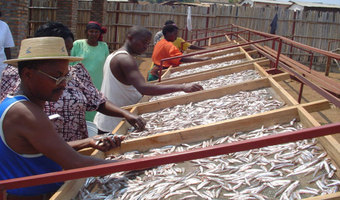 A new method of drying fish using low cost racks is reducing drying time from three days to eight hours while doubling market prices among East African fishing communities.
A new method of drying fish using low cost racks is reducing drying time from three days to eight hours while doubling market prices among East African fishing communities.
Once fish is harvested, the most fishermen dry them on the ground, and therein lies the problem. Besides being easy pickings for animals, the fish stocks are vulnerable to being stepped on or even contaminated. And when it rains the fish are washed away or contaminated.
Fishermen have always lost upto 15 percent of their catch in this process of drying them. “Fish has to be put on the ground immediately after harvest to allow some bit of drying and to at least prolonging their shelf life,” said Mathias Okongo a fisherman in Lake Victoria who has been in the business for the last five years.
At every harvest, he used to loose upto 10 percent of his catch to either animals or the fish going bad before they can reach the market.
He now are sleeps easy having embraced simple raised racks which he and his peers use to dry the fish and which have assisted them kiss goodbye the agony of rotting and lost fish stocks which they used to dry on the ground.
The racks introduced to them by Food And Agriculture Organization FAO has reduced drying time from three days to eight hours meaning producers can dry multiple batches of fish in the same day.
The racks were first used in Burundi where they registered stellar uptake.
“If the fishes got spoiled and began to smell awfully it was impossible to sell them at market,” said Gabriel Butoyi, president of Rumonge fishing port in Burundi.
The 48 cheap wire-mesh racks suspended a metre above the ground, have also kept the fish out of reach of animals. The racks are also be covered when it rains, preventing spoilage.
“Our fishes are of a good quality without small gravel or stones and they are dried in hygienic conditions,” said rack owner Domitien Ndabaneze. “With our products, customers are no longer concerned with eating sandy fish.”
Word spread fast among fishing communities, and the use of racks exploded along the shores of the lake. The area dedicated to fish drying near the village of Mvugo has increased from one acre in 2004 to five acres today, and the number of driers at all official fishing sites along the shores of Lake Tanganyika has increased from 500 to over 2 000
The quantity of fish lost or wasted due to inadequate drying practices has more than halved, and as the quality of the dried fish has improved, prices have more than doubled, from Sh200 a kg) 2004 to Sh700 in 2013.
The rack drying technique also reduces daily drudgery for the driers, as women no longer have to bend down to spread and turn fish on the ground.
Small-scale operations have sprung up providing the material for, and building, the racks, also helping to improve the livelihoods of fishing communities and the local economy.
Yet at the same time, the increase in supply has not put greater pressure on the lake’s resources, as the amount of fish being taken from the lake has remained relatively stable.
















Comments powered by CComment